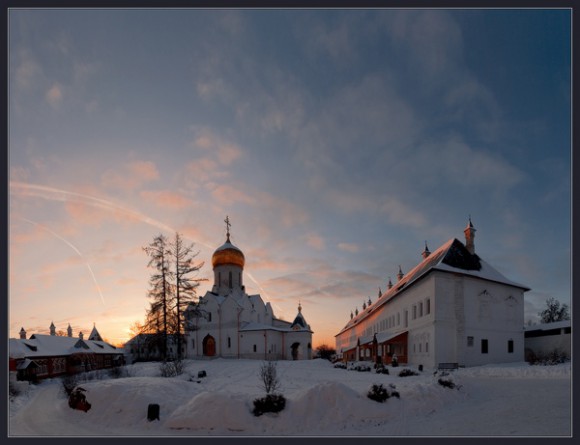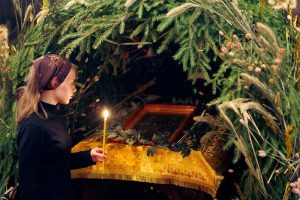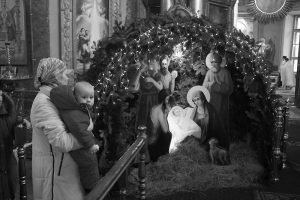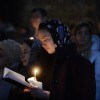In recent years there has been a renewed emphasis on the cycle of the liturgical year. The traditions of an earlier age are being presented to the contemporary membership of our churches in an attempt to bring a spiritual element to the cycle of daily life, which has become so secularized.
One of the most important seasons to be re-discovered has been the season of Advent, the fast before the celebration of Christmas. Advent, the Western name of this fast period, comes from the Latin verb “advenire” meaning “to reach” or “to arrive at.” Advent is the preparation for the arrival of the Messiah in the birth of the Christ Child.
Among Western Christians the Advent season begins on the fourth Sunday before Christmas and ends on Christmas Eve. The four candles of the Advent wreath represent the four Sundays of Advent. Advent also marks, for Western Christians, the beginning of the Church year.
The season of Advent, or as it is most often referred to in the Orthodox Liturgical books, the Nativity Fast, begins in the Orthodox Church on the day after the Feast of the Apostle Philip, November 15th (November 28th). In fact, it was popularly referred to by Carpatho-Rusins as Philipovka, that is “Philip’s Fast.”
According to legend, St. Philip the Apostle called down the wrath of God upon those who were torturing him to death. As a penance for presuming on the vengeance of God, it was revealed to him by an angel that he would not enter paradise until forty days after his death. Philip then sent word to the other living Apostles and begged them to fast for forty days after his death. The Canons attributed to St. John the Faster, the sixth century Patriarch of Constantinople, do in fact refer to this fast as the fast of St. Philip.
While it is entirely possible that this fast began as a popular custom not necessarily associated with Christmas, it is more likely that the forty day fast grew out of an attempt to imitate the fast of Great Lent preceding Pascha. Although it was only in the fourth century that the Feast of the Nativity of Christ was celebrated by itself on December 25th, from its inception it was seen as a feast only rivaled by the Resurrection. The celebration of the Incarnation of the Word of God provided an excellent forum for the Churchmen of the late fourth and early fifth centuries to attack the then rampant heresies of Arianism (denial that Jesus, as the “Word” of God, was of one essence with God the Father) and Monophysitism (denial of the effective presence of the human nature in Christ).

photosight.ru
The Advent Fast, just as with the Lenten fast, developed from popular piety reflecting on the Scriptural fasts. However, unlike the Lenten fast, which was soon regulated by the Church in terms of its severity and duration, the Advent fast’s severity and duration were for many centuries governed by local custom and tradition. It was not until 1166 that a church council meeting in Constantinople fixed the length of the fast at forty days. However, the famous Canonist and Patriarch, Theodore Balsamon of the Great Church of Constantinople (1185-1204), noted in interpreting this council that only monastics were obligated to keep the forty days and that lay people might shorten it to only seven days.
It is interesting to note that unlike Great Lent, with its Canon of St. Andrew of Crete, Presanctified Liturgies and Lenten Triodion, the liturgical life of the Church scarcely notices the existence of Advent. The Sundays are observed as “Sundays after Pentecost” and there are no special services prescribed. The approach of Christmas is mentioned only on the two Sundays directly preceding it, although the Christmas Canon (Christ is Born, glorify him…) is sung as a refrain at the Matins for the Presentation of the Mother of God on November 21st and also on St. Nicholas Day on December 6th.
One of the perpetual questions that is always asked at this time of year is, “when is it proper to sing Christmas Carols or decorate for Christmas.” Unlike the Fast of Lent, which is really a preparation for Holy Week, the Nativity Fast is one of joyful expectation. As mentioned above, the Church begins to sing “Christ is born, glorify Him!” already on November 21st (December 4th). There is nothing wrong or inappropriate about decorating or singing the traditional Kol’jady after the fourth of December (or November 21st on the New Calendar). Unfortunately, since Matins has been discontinued in many of our churches, this refrain is no longer heard. This fact, coupled with the feeling in many “Old Calendar” parishes that to decorate the Church or to sing the Kol’jady before Christmas Eve will somehow mean that the Calendar is being changed, often leads to the practice of refusing to do anything that pertains to the Nativity until after December 25th.
Besides singing the Christmas Canon at Matins, the Kontakion of the Preparation for the Nativity is to be sung on the Sunday after the Feast of the Presentation of the Mother of God and to continue through the Advent season until the Nativity. In some parishes the custom still exists of having either Paraklis’ or other devotions to the Mother of God during the Advent season. However, these are considered “paraliturgical” services that are celebrated out of piety. They are not formally prescribed by the Church.
The tremendous influence of monasticism after the fall of Constantinople in 1204, certainly contributed to the observance of the forty-day Nativity Fast by all Orthodox Christians, whether they were monastics or not. In light of the gross materialism of the secular Advent – the Christmas shopping season – the season of Advent has a valuable place in our spiritual lives. Through this season’s emphasis on prayer, fasting and charity, the spiritual reality of Christ’s Incarnation is brought to bear on our daily lives, thereby preparing us to welcome the Messiah into our hearts at time of His Advent.
Source: American Carpatho-Russian Orthodox Diocese of the U.S.A

















